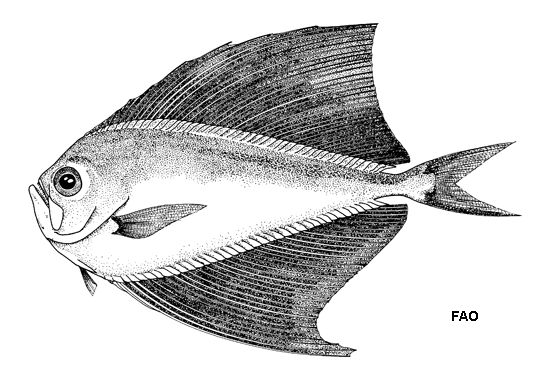Prickly Fanfish, Pterycombus petersii (Hilgendorf 1878)
Other Names: Prickly Pomfret

An illustration of a Prickly Fanfish, Pterycombus petersii. Source: FAO / EOL. License: CC BY Attribution-Noncommercial
Summary:
A bronze to silvery grey pomfret with black dorsal, anal and pelvic fins, a very large eye, and a deeply forked tail. The anterior dorsal and anal fins are elongate, and increase in height anteriorly to above the pectoral fin, and the fins can be depressed into a sheathed groove formed by enlarged modified scales; the anterior dorsal and anal-fin rays are similar, with no distinct thickening. The dorsal fin originates above or behind the rear of the eye, and the modified scaly sheath does not extend forward beyond the dorsal-fin base.
Cite this page as:
Bray, D.J. 2020, Pterycombus petersii in Fishes of Australia, accessed 03 Jul 2025, https://fishesofaustralia.net.au/home/species/411
Prickly Fanfish, Pterycombus petersii (Hilgendorf 1878)
More Info
|
Distribution |
Exmouth Plateau and the North West Shelf, Western Australia, and off Osprey Reef in the Coral Sea, Queensland to west of South West Cape, Tasmania. Elsewhere the species is widespread in the Indo Pacific at mesopelagic depths. Larvae and small juveniles are epipelagic. |
|
Features |
Dorsal fin 47-49; Anal fin 37-40; Pectoral fin 19-22; Vertebrae 45-48; Scales in horizontal series 48-51; Predorsal scales 10. Body elongate, compressed; snout short; mouth oblique, upper jaw extending to a vertical through middle of eye; palatine and prevomer without teeth. Dorsal fin inserted above or behind rear part of eye; dorsal and anal fins very high, with scaly sheaths at bases; no rays of dorsal and anal fins thicker than neighbors. |
|
Species Citation |
Centropholis petersii Hilgendorf 1878, Sitzungsberichte der Gesellschaft Naturforschender Freunde zu Berlin 1878: 1. Type locality: Japan. |
|
Author |
Bray, D.J. 2020 |
|
Resources |
Prickly Fanfish, Pterycombus petersii (Hilgendorf 1878)
References
Hilgendorf, F.M. 1878. Über das Vorkommen einer Brama-Art und einer neuen Fischgattung Centropholis aus der Nachbarschaft des genus Brama in den japanischen Meeren. Sitzungsberichte der Gesellschaft Naturforschender Freunde zu Berlin 1878: 1-2
Last, P.R. & Baron, M. 1994. Rays bream: a new pelagic fishery? Australian Fisheries 53(8): 19-22
Last, P.R. & Moteki, M. 2001. Bramidae. pp. 2824-2836 in Carpenter, K.E. & Niem, V.H. (eds). The Living Marine Resources of the Western Central Pacific. FAO Species Identification Guide for Fisheries Purposes. Rome : FAO Vol. 5 2791-3379 pp.
Mead, G.W. 1972. Bramidae. Dana Reports 81: 1-166 figs 1-58 pls 1-9
Paulin, C., Stewart, A., Roberts, C. & McMillan, P. 1989. New Zealand fish: a complete guide. National Museum of New Zealand Miscellaneous Series 19: 1-279
Stewart, A.L., Struthers, C.D. & Last, P.R. 2015. 180 Family Bramidae. pp. 1263-1271 in Roberts, C.D., Stewart, A.L. & Struthers, C.D. (eds). The Fishes of New Zealand. Wellington : Te Papa Press Vol. 4 pp. 1153-1748.



